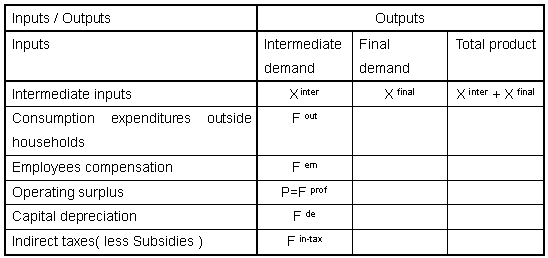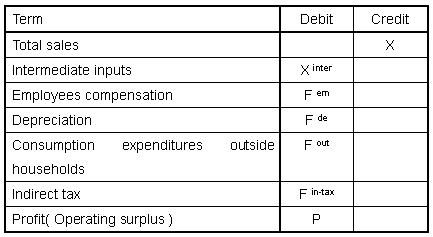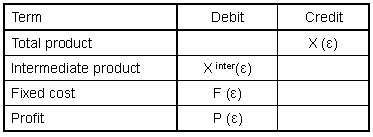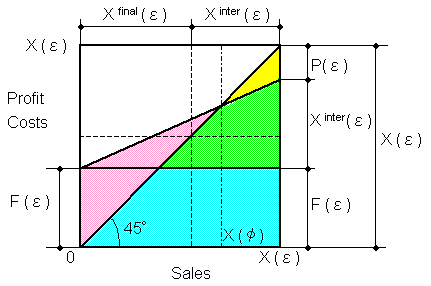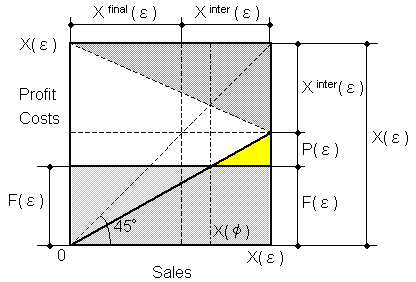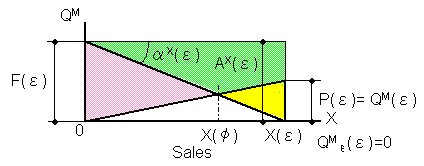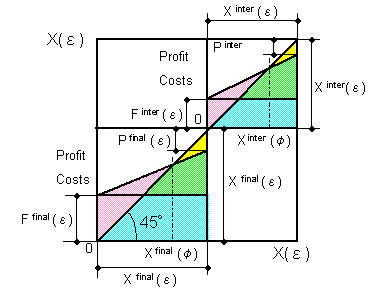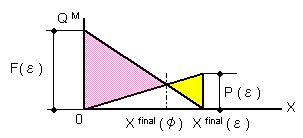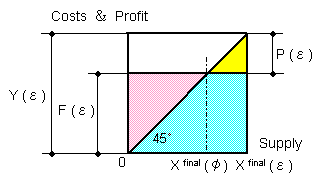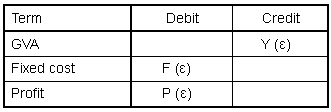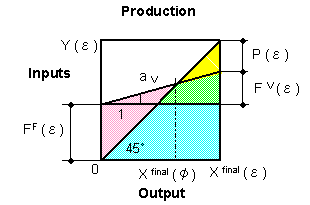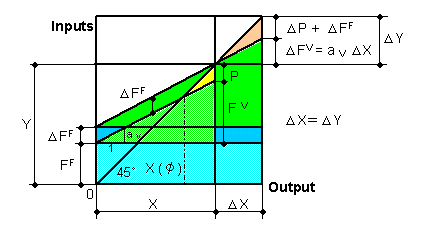§2 Input-Output Table Chart in National Economic Accounts
| Keynes' principle of effective demand based on the Keynesian multiplier effect is mathematically wrong. |
| The Keynesian multiplier effect doesn't exist. | ||
|
DCE Yuichiro Hayashi |
||
| In this section, the term "goods" always includes services. In this description the following are assumed: | ||
| (1) Inventories are included in final supply; | ||
| (2) Inflation and deflation do not exist. | ||
| National accounts consist of: the production, income and consumption accounts; the balance sheet; the input-output table. They are essentially made by aggregating each individual account in firms, households, government, banks etc. The relationship between a firm’s income statement and its profit chart has been presented in this website. Each firm's income statement has its individual break-even chart. The national production account is made by aggregating the individual income statements, no matter how many of those exist. Consequently, it is naturally supposed that the national production account has its break-even chart. This is not logical assumption but induction. | ||
| The managed gross profit chart theory will be developed in the "Input-Output Table" by Leontief. The simplest case is shown in Table 2-1. In the table, the aggregate of matrix terms is shown. The symbol F expresses fixed cost. | ||
|
Table 2-1 Input-output table |
||
|
|
||
| In Table 2-1, final demand is composed of consumption expenditures outside households, private consumption, government consumption, fixed asset formation, the incremental inventory and exports ( less imports). | ||
| When we treat consumption C at the same time, it should be noted that the employees compensation doesn't correspond to the all wages received by the people who expend consumption C. | ||
| Table 2-1 is transformed to Table
2-2, where the
following notation is
used. |
||
| X= X inter + X final | ||
| When
we regard the intermediate
inputs |
||
|
Table 2-2 National production account-1 |
||
|
|
||
| The section , "Outline of managed gross profit theory " is referred to in the following explanation. The following notations are used: | ||
| X
= X (ε)
= X
inter |
||
| X
inter |
||
| F
= F (ε) = F
inter |
||
|
= F em |
||
| P = P (ε) = P inter (ε)+P final (ε) : profit | ||
| ε: means data on income statements at the end of a fiscal period. | ||
| We assume, in this account, that: | ||
|
1 production and sales are equal with each other at the end of the fiscal period; |
||
|
2 the 2nd kind of overhead applied does not exist; |
||
|
3 the normal allocation ratio for F (ε) is F (ε) / X (ε). This means that the capacity of F (ε) is F (ε) itself. |
||
| With these assumptions and notations, the account in Table 2-2 changes to Table 2-3. | ||
| Table 2-3 National production account-2 | ||
|
|
||
| We have many equations for charting in the above-mentioned section. Using the previous assumptions, we have the following equations from the section: | ||
| AY (ε) = η (ε)= δ (ε)= G (ε)=0 | (2-1) | |
| QM (ε) = X (ε) - D (ε) - AX (ε) | (2-2) | |
| AX (ε) = F (ε) | (2-3) | |
| tan α X (ε) = F (ε) / X (ε) | (2-4) | |
| Q M ξ (ε) = F (ε) - X (ε) tan α X (ε) | ||
| = 0 | (2-5) | |
| P (ε) = QM (ε) | (2-6) | |
| From these equations, the following break-even charts are obtained. Table 2-3 is formally changed to Fig.2-1. | ||
|
|
||
| Fig. 2-1 Input-output table chart-1 | ||
| Fig.2-1 is equivalent to Fig.2-2. | ||
|
|
||
| Fig. 2-2 Input-output table chart-2 | ||
| When we express Fig.2-1 and Fig.2-2 as the managed gross profit chart, we have Fig.2-3. | ||
|
|
||
| Fig. 2-3 Input-output table chart-3 | ||
| Fig. 2-1 is really the sum of
the two charts, X
inter |
||
|
|
||
|
Fig. 2-4 Input-output table chart 2-4 |
||
| The relationship between Fig. 2-1 and Fig. 2-4 is explained in two ways: | ||
| 1 We assume that Fig. 2-4 is the total of actual income statements which are presented by internal-goods-industries and final-goods-industries, if such separation is possible; | ||
| 2
We assume that an allocation system
under standard costing is adopted in Fig.2-1, and the applied
costs and profits are distributed to X
inter |
||
| In
Fig. 2-3, the off-setting of X
inter |
||
|
|
||
| Fig. 2-5 Input-output table chart-5 | ||
|
|
||
| Fig. 2-6 Input-output table chart-6 | ||
| In Fig. 2-6, the notation Y (ε) = F (ε) + P (ε) has been used. Y (ε) is the "Gross Value Added" shown in Table 2-4. | ||
| Table 2-4 National production account-3 | ||
|
|
||
| In Fig. 2-1~ Fig. 2-5, the horizontal axis has been expressed as supply or sales and the vertical axis as costs and profit. The supply or the sales is output and the costs and the profit are input energy to provide supply. From Fig.2-6, the following equation is obtained: | ||
|
X |
(2-7) | |
| In deriving Fig. 2-6, we have used the two terms, fixed cost F (ε) and profit P (ε). However, F (ε) can be separated into a final fixed cost and a final variable cost. Using the notation F (ε) = FV (variable cost) + FF (ε) (fixed cost) and a V= FV (ε) / X final (ε), Fig. 2-6 changes to Fig. 2-7. | ||
|
|
||
|
|
||
|
Fig. 2-7 Input-output table chart-2-7 |
||
| In Fig. 2-7, we have: | ||
|
X final (Φ) / X final (ε)= FF (ε) / (X final (ε) - FV (ε)) |
(2-8) | |
| Fig. 2-7 is the basic figure showing the relationship between aggregate supply( output) and total inputs injected into products. It should be noted that we have not separated goods into final consumption goods and final capital goods in X final (ε) in these derivations. | ||
|
|
||
|
We will consider how much the
incremental demand Δ X final |
||
|
|
||
|
|
||
|
Fig. 2-8 Relationship between incremental inputs and output |
||
| The terms such as X , Y, P, FV, FF and a V (= FV / X) always change in actual firms or the economy, as explained in §4 'Preparation for Economics'. On one occasion, they move independently of each other whilst keeping the total X, and on another occasion, they move in relation to each other. | ||
| The variable costs of intermediate goods are not taken into consideration in Fig. 2-8. The reason is that the value of intermediate goods is subtracted from both the inputs and output. In §4 (ibid.), the ratio ' a ' means the ' Variable cost ratio '. In a firm's income statement, the variable costs are composed of its labor costs, amount paid to sub-contractors and other variable costs. In Fig. 2-8 in the national economic accounts, the amount paid to sub-contractors and the other variable costs are mainly labor costs included in the final goods. Consequently, the variable cost ratio a V means, as a matter of fact, the ' variable employees compensation ratio' in the national economic accounts. | ||
| Does the variable cost ratio a V relate to the ' Marginal Propensity to Consume (MPC) ' in the Keynesian multiplier effect ? This problem will be studied in the next chapter. | ||
